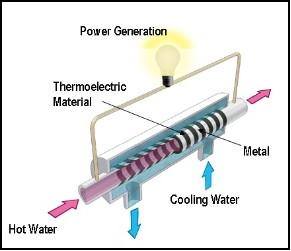
The Osaka, Japan-based maker and developer of globally-distributed electronic products for consumer, business and industrial use has developed thermoelectric tubes that the company says can be used for geothermal electricity
generation and waste heat recovery.
The company press release says this:
“Panasonic has developed innovative thermoelectric tubes especially suited for fluid heat source such as hot water and steam. The tubular shape enables direct and efficient heat transfer without additional heat exchangers, yielding high density of generated power. Panasonic’s thermoelectric tube with simple, compact, and efficient features is an ideal solution for capturing unused or wasted heat from hot springs and factory.
“Thermoelectric technology is the direct energy conversion from heat into electricity and has attracted much attention as a renewable energy solution. Since conventional thermoelectric generators are complicated in structure and restricted in planar shape, they are difficult to scale-up and implement. Panasonic’s thermoelectric tubes solve these problems by using unconventional phenomena called transverse thermoelectric effect, which takes place in tilted multilayer made of thermally-resistive thermoelectric materials and thermally-conductive metals. This effect makes it possible to control heat flow and electric current independently in materials, and realizes quite simple structure without complicated electric junctions and planar substrates.
“The performance of power generation is strongly dependent on many parameters such as size of the tube and amount of heat source. Panasonic has developed the simulation technology to optimize the design of the thermoelectric tube in order to maximize the output electric power in accordance with surrounding conditions.
“The thermoelectric tube is constructed by stacking conical rings of bismuth telluride as thermoelectric material and nickel as metal. Panasonic has developed processing technologies in fabricating conical rings of brittle thermoelectric materials and bonding rings with minimum parasitic electric and thermal losses.
“The 10 cm-long ( 4 inch) fabricated thermoelectric tube using technologies introduced above can generate 1.3 W of electricity by running hot water of 90 degrees C (194 F) inside, and cold water of 10 degrees C (50 F) outside the tube. The power density corresponds to as high as 10 kW with only 1 m3 (cubic meter)of volume. Development on system design, optimization in manufacturing and feasibility study are now under way or planned, with a view to realizing compact, efficient, and economical generators fueled by geothermal energy and waste heat in factories.
On this development, Panasonic holds 29 domestic patents and 12 overseas patents, including pending applications.”
Structure of tilted multilayer made of thermoelectric materials and metal
The technology is scalable, according to the release. The thermoelectric tubes can made larger and more powerful. This is good. Yet there are questions that Panasonic will need to answer during the coming months or years, for example:
— What will they cost on per Watt basis? (Always what people want to know.)
— If relatively low temperature geothermal heat can be used, why not relatively low temperature solar heat?
— The company mentions cooling water: “10 degrees C (50 F) outside the tube.” Where would this cool water come from, natural sources such as ground water? Or, what would be used to chill water, artificial cooling which requires energy?
Thermoelectric devices – those which convert heat directly to electricity – are commonly used in a variety of applications. If you have a gas water heater at home you likely have a thermocouple ( a type of thermoelectric device) that shuts the gas off to the pilot light if it is extinguished, blows out. Thermoelectric devices have proven to be reliable over years of use.
However, others have attempted to scale up this technology into large, useful amounts of electric power – and failed. Perhaps Panasonic will be successful. The company has a good track record of producing state-of-the-art, durable, high-quality products.
This invention is worth watching. There’s no shortage of excess manmade or natural thermal energy out there. Putting that energy to work would be a game-changer.
Article courtesy of green-energy-news.com

